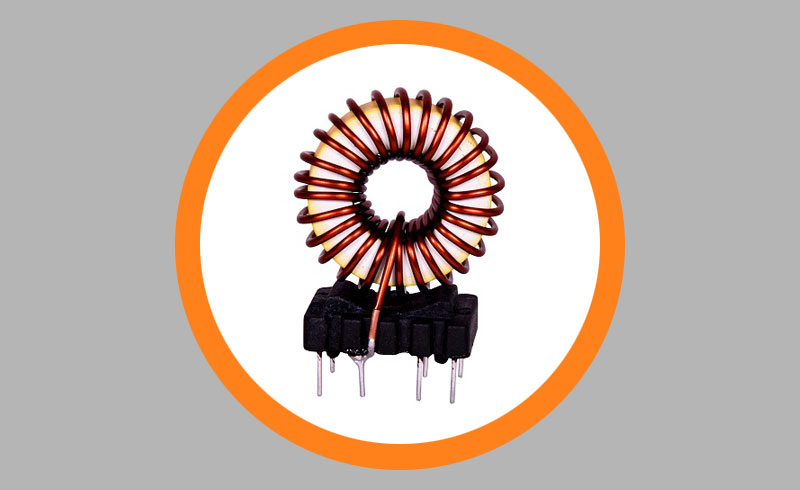No Product Added

By : Shah Electronics

In today's fast-paced world of electronics, ensuring smooth and interference-free operation is a constant challenge. Electromagnetic interference (EMI) can disrupt your devices, causing performance issues and potentially damaging sensitive components. At Shah Electronics, we're committed to helping you tackle this issue head-on. Let us understand more about Common Mode Chokes and effective strategies for EMI Control.
Common mode chokes, often called choke coils, are passive electronic components designed to suppress unwanted electromagnetic interference. They work by impeding the flow of common mode currents while permitting differential mode currents to pass through unobstructed. Common mode chokes consist of coils wound around a magnetic core, typically made from materials like ferrite or powdered iron.
Let us understand them in simpler terms - Common mode chokes are like traffic cops for electronic signals. Think of them as filters that make sure only the signals that are supposed to get through do, while the disruptive ones are blocked. This helps keep your electronic devices running without any interference or disruptions.
Understanding the different types of common mode chokes is essential for choosing the right solution for your specific needs. Here are some types you need to know about:
Ferrite bead chokes are compact, cost-effective, and effective at high frequencies. They are commonly used to filter high-frequency EMI noise. These are like tiny magnets for electronic noise. They are great at catching and stopping high-frequency interference. You will often find them in things like your computer or smartphone.
Toroidal chokes feature a ring-shaped core, providing excellent inductance and EMI suppression capabilities. They are often used in power supplies and audio equipment. Think of them as donut-shaped guards against electronic noise. They are super at blocking interference and are used in power supplies and audio equipment.
Cable chokes are designed to be placed on cables or wires to prevent EMI from being transmitted along the cable. They are crucial in audio and data transmission applications. These are like special rings for your wires. They are placed on cables to stop noise from traveling through them. They are important for keeping your audio and data cables clear of unwanted noise.
Common mode chokes are versatile components with a broad spectrum of applications. Whether you are using your smartphone, enjoying high-quality audio, or benefiting from the advancements in medical technology, common mode chokes are working behind the scenes to make it all happen. Here are some common areas where they are employed:
Common mode chokes are commonly used in power supplies. They play a crucial role in filtering out electromagnetic interference (EMI) generated by switching power converters.
In power supplies, especially in those found in computers, TVs, and other electronics, common mode chokes help ensure clean and stable power delivery. This is essential to prevent disruptions, voltage fluctuations, and damage to sensitive components.
For data communication systems like Ethernet and USB, common mode chokes help eliminate EMI that could otherwise degrade signal quality. In these applications, it is vital to eliminate EMI that can degrade signal quality and hinder data transmission. Common mode chokes are used to filter out noise and maintain a clear and reliable data stream.
In audio equipment such as amplifiers and mixers, common mode chokes are instrumental in reducing unwanted noise. They work to reduce unwanted noise and interference, ensuring that you hear clear, crisp audio without any annoying background hiss or distortion. This is especially important in professional audio setups and high-end consumer audio systems.
Achieving effective EMI control involves more than just installing common mode chokes. To keep EMI under control, you need effective strategies. Here are some key strategies for EMI control:
Grounding is like giving your electronics a safe pathway for excess electrical energy to escape. It prevents electrical "noise" from building up and causing interference. Improper grounding can exacerbate EMI issues. Thus ensuring that your electronic devices and systems are correctly grounded is the first and foremost step in EMI control.
Think of shielding as creating a protective barrier around your electronic components or systems. Shielding materials, such as conductive enclosures or metallic shields, block EMI from entering or escaping. This keeps your sensitive components safe from external interference.
Where you place electronic components can significantly affect EMI. In high-frequency circuits, it is crucial to strategically position components to minimize electromagnetic interference. This can involve keeping sensitive components away from potential sources of interference.
EMI filters, often used in conjunction with common mode chokes, are specialized components designed to remove unwanted noise from electrical circuits. These filters come in various forms, such as capacitors and inductors, and they are strategically placed to filter out EMI. They work to ensure that only the clean and desired signals pass through.
Long cables and loops can act as antennas, picking up and transmitting EMI. Minimizing cable lengths and reducing unnecessary loops in wiring can help mitigate this issue.
Segregate sensitive components from potential sources of EMI. For example, keep power cables separate from data cables to prevent EMI from power sources affecting data transmission.
Shielded cables are essential for applications where EMI control is crucial. Shielded cables use a metallic shield to protect the signal-carrying conductor from external EMI.
By implementing these EMI control strategies, you can safeguard the proper functioning of your electronic devices and systems, ensuring that they operate reliably and interference-free. Whether you are designing a new electronic product or troubleshooting EMI issues in an existing system, these strategies can make a significant difference in maintaining optimal performance. By understanding their types, applications, and incorporating various EMI control strategies, you can create reliable electronic systems. Shah Electronics is here to assist you on your journey to EMI control, offering high-quality common mode chokes and expert advice to help you achieve the best results.
© 2025. Shah Electronics. All Rights Reserved. Terms of Use Privacy Policy Cookie Policy
Terms of Use
Privacy Policy
Cookie Policy
© 2025. Shah Electronics. All Rights Reserved.
Powered by WEBMANTRA